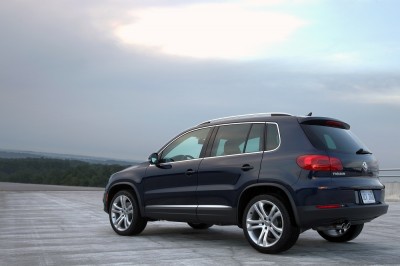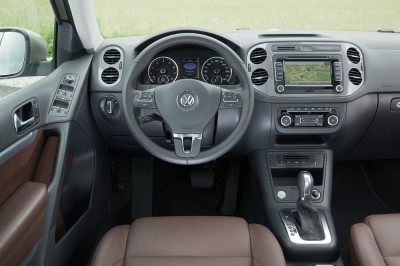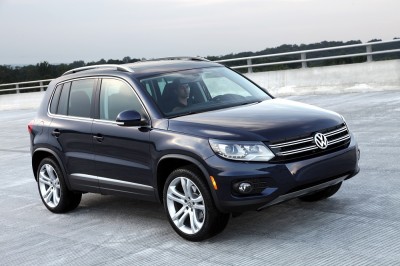 How do I explain the Volkswagen Tiguan?
How do I explain the Volkswagen Tiguan?
First, that’s a made-up name that supposedly conjures an image of a snarling tiger mixed with a slithering iguana. Is it meant to be a menacing meat-eater or an aquarium pet for the reptile-obsessed? Maybe you put the tiger in the tank and an iguana in the boot? It’s all so confusing. Fortunately, it’s easier to get a fix on the machine itself.
Or maybe not. The Tiguan looks like a VW Golf that was stretched like silly putty before its introduction at a women’s volleyball tournament. It’s a bit girly, but hey, we gays have never shied away from girly rides (ahem, VW Eos and Beetle). A closer look reveals deft hood surfacing, hunky wheelwells, large alloys, and a perky booty. Basking in the right scenery, it could almost look like a small Land Rover. Almost. In the real world, you won’t confuse it for anything but a Volkswagen.

On the other side of the threshold is pure Teutonic glory. Seats are firm, but comfortable. Gauges are big and round. The touchscreen could be easier to use, but no big complaints. Air vents look like they were confiscated from some industrial site, but they blow ice cold air…sitting in traffic…on 95-degree days…instantly. Unlike in the Jetta, VW’s bean-counters allowed designers to spend a few for padding on the doors and dashtop. VW’s leather-wrapped steering wheel is among my faves. Look to higher trim packages for navigation, Fender audio, and heated leather.
VWs earn street cred through their authentic, sure-footed German driving experience. Steering on the Tiguan is light but precise, brakes gain power with the right progression, and automatic transmissions can be easily shifted by a thoughtful big toe. Everything is intuitive and runs with the precision of a Pullman’s conductor.
Keeping things simple, the Tiguan comes standard with a 200 horsepower, 2.0-liter turbo-four that achieves 18 mpg city/26 mpg highway. Even factoring in 4-Motion all-wheel-drive, those numbers are less than exceptional. The six-speed automatic transmission is a wonder of precision, but apparently does little to boost mpgs. Fortunately, the Tiguan is about driving pleasure as much as sipping fossils. If it helps, pretend that gas is still $2 a gallon.

My partner and I own one of the Tiguan’s Euro-built competitors. With less than 15,000 miles on the clock, it rattles like the inside of a marble bowl. It’s ridiculous. I wish we’d bought Tiguan, where nothing even thinks about acting unruly. It just rumbles over pavement without piping a whisper. And when it finds open highway, the four-wheel independent suspension rides comfortably, but is ready to play in the hills and curves.
I have to admit I paid the Tiguan little mind in the past. To me, it was just another stretched and pimped Volkswagen that lacked any creativity. That may still be true, but the Tiguan is one of the best-driving crossovers on the road and quickly explains itself. If you put a premium on German performance, this could be the cold-blooded, hot-panting crossover for you. Prices start at $22,995 for a base model with a stick, but you should expect to spend $29,500 for our SE trim.
Storm Forward!
2013 Volkswagen Tiguan SE
Five-passenger, AWD Crossover
Powertrain: 200hp 2.0-liter Turbo-4, 6-speed automatic transmission
Suspension f/r: Ind/Ind
Wheels: 17”/17” alloy f/r
Brakes: disc/disc fr/rr with ABS
Must-have features: Power, handling
Fuel economy: 18/26 mpg city/hwy
Assembly: Wolfsburg, Germany
Base/as-tested price: $22,995/29,500
